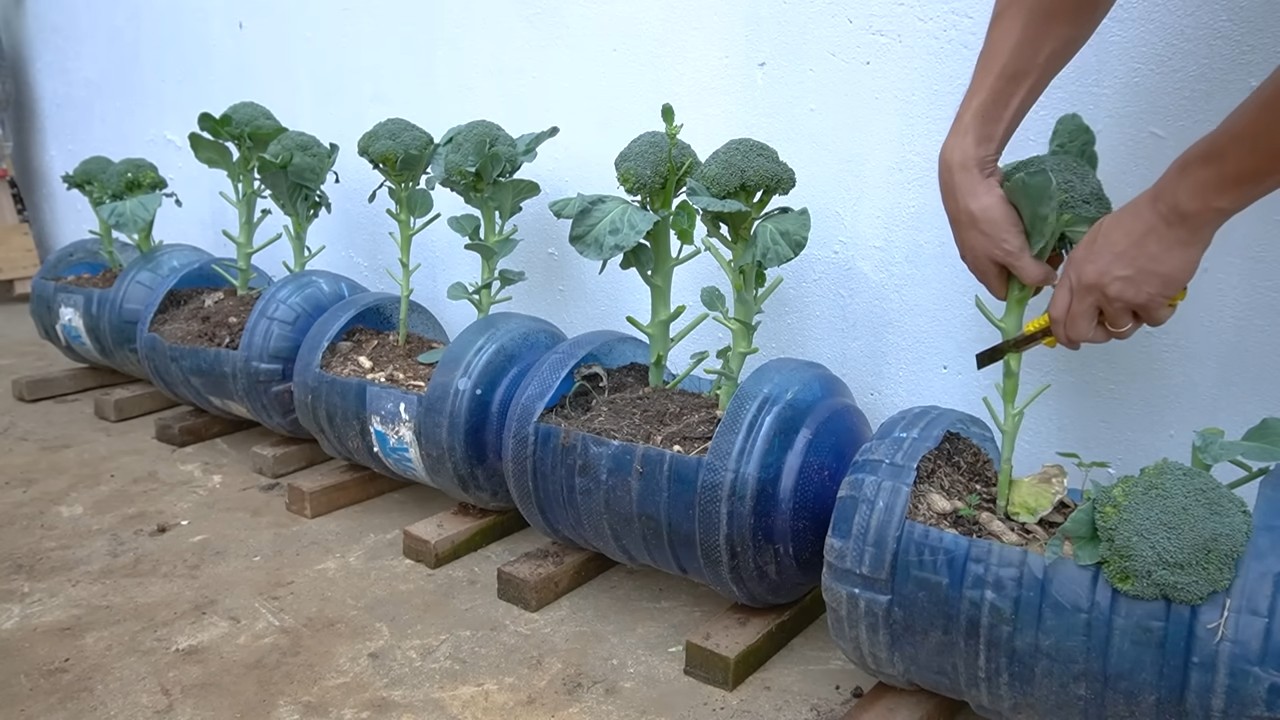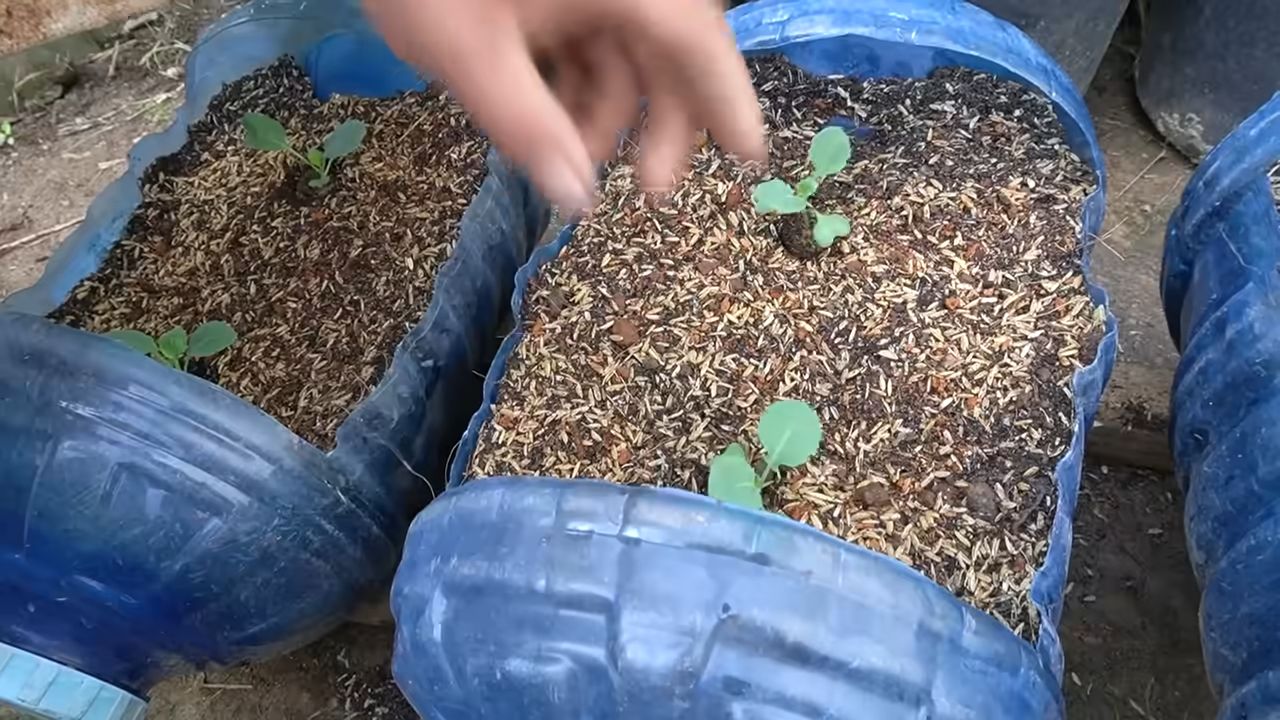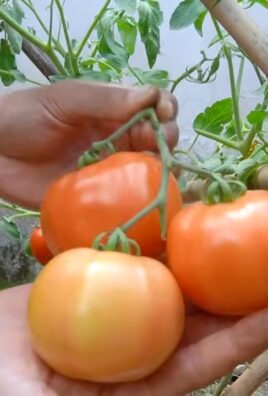Grow Broccoli at Home 鈥?sounds intimidating, right? But trust me, it’s way easier (and more rewarding!) than you might think. Forget those pricey, sometimes-questionable heads of broccoli from the grocery store. Imagine stepping out into your own backyard and harvesting crisp, vibrant, and utterly delicious broccoli whenever you crave it. This DIY guide is your secret weapon to achieving just that!
Broccoli, a member of the brassica family, has a fascinating history. Originating in Italy, its name comes from the Italian word “broccolo,” meaning “the flowering crest of a cabbage.” For centuries, it was a culinary staple in the Mediterranean before making its way to the rest of the world. Now, you can bring that rich history and fresh flavor right to your table.
Why should you bother learning how to grow broccoli at home? Well, for starters, homegrown broccoli tastes infinitely better than store-bought. Plus, you control exactly what goes into your garden, ensuring your broccoli is free from harmful pesticides and chemicals. In today’s world, knowing where your food comes from is more important than ever. This DIY project not only provides you with fresh, healthy produce but also connects you to the earth and the satisfaction of nurturing something from seed to table. So, let’s dive in and unlock the secrets to a bountiful broccoli harvest!

Grow Your Own Broccoli: A Beginner’s Guide
Hey there, fellow garden enthusiasts! Ever thought about growing your own broccoli? It’s surprisingly easier than you might think, and the taste of homegrown broccoli is simply unbeatable. Plus, you’ll know exactly where your food is coming from and what’s gone into growing it. I’m going to walk you through everything you need to know to successfully cultivate this nutritious veggie right in your backyard (or even in containers!).
Choosing Your Broccoli Variety
First things first, let’s talk about broccoli varieties. There are tons to choose from, each with its own unique characteristics. Here are a few popular options:
* Calabrese: This is your classic broccoli, producing a large central head. It’s a reliable choice and a great option for beginners.
* Waltham 29: Another dependable variety, known for its cold hardiness. Perfect if you live in an area with cooler temperatures.
* DiCicco: This variety produces smaller central heads, followed by numerous side shoots. It’s a good choice if you want a continuous harvest over a longer period.
* Romanesco: If you’re feeling adventurous, try Romanesco broccoli. It has a unique, fractal-like appearance and a slightly nutty flavor.
Consider your local climate and growing season when making your choice. Check with your local nursery or garden center for recommendations on varieties that thrive in your area.
Getting Started: Seeds vs. Transplants
You have two main options for starting your broccoli: from seeds or from transplants (small plants that have already been started).
* Starting from Seeds: This gives you more control over the entire growing process and is generally more economical. However, it requires a bit more time and effort.
* Using Transplants: This is a quicker and easier option, especially for beginners. You can purchase transplants from a nursery or garden center.
I personally prefer starting from seeds, as I find it more rewarding. But if you’re short on time or new to gardening, transplants are a great way to go.
Starting Broccoli from Seeds (Indoors)
If you’re opting for seeds, you’ll need to start them indoors about 6-8 weeks before the last expected frost in your area. This gives them a head start and ensures they’re strong enough to withstand the outdoor elements.
1. Gather Your Supplies: You’ll need seed starting trays or small pots, seed starting mix (a light, well-draining soil specifically formulated for seedlings), broccoli seeds, a spray bottle, and a grow light (optional, but highly recommended).
2. Sow the Seeds: Fill your seed starting trays or pots with seed starting mix. Moisten the soil with the spray bottle. Sow 2-3 broccoli seeds per cell or pot, about 1/4 inch deep. Gently cover the seeds with soil.
3. Provide Light and Warmth: Place the trays or pots in a warm location (around 70-75掳F) and under a grow light if you have one. If you don’t have a grow light, place them near a sunny window, but be sure to rotate them regularly to prevent them from leaning towards the light.
4. Keep the Soil Moist: Water the seedlings regularly with the spray bottle, keeping the soil consistently moist but not soggy.
5. Thin the Seedlings: Once the seedlings have emerged and have a couple of true leaves (the second set of leaves that appear after the initial seed leaves), thin them to one seedling per cell or pot. Choose the strongest, healthiest-looking seedling and gently snip off the others at the soil line.
6. Harden Off the Seedlings: About a week before you plan to transplant the seedlings outdoors, you’ll need to “harden them off.” This process gradually acclimates them to the outdoor conditions. Start by placing the seedlings outdoors in a sheltered location for a few hours each day, gradually increasing the amount of time they spend outside. Protect them from direct sunlight and strong winds.
Preparing Your Garden Bed
Broccoli thrives in well-drained soil that is rich in organic matter. Before transplanting your seedlings or sowing seeds directly into the garden, you’ll need to prepare the soil.
1. Choose a Sunny Location: Broccoli needs at least 6 hours of sunlight per day. Choose a location in your garden that receives plenty of sun.
2. Amend the Soil: Dig in plenty of compost or well-rotted manure to improve the soil’s drainage and fertility. Broccoli is a heavy feeder, so it needs a nutrient-rich soil.
3. Check the Soil pH: Broccoli prefers a soil pH between 6.0 and 7.0. You can test your soil pH using a soil testing kit. If your soil is too acidic, you can add lime to raise the pH. If it’s too alkaline, you can add sulfur to lower the pH.
4. Create Raised Beds (Optional): Raised beds can improve drainage and warm up the soil more quickly in the spring. If your soil is heavy clay, raised beds are a good idea.
Transplanting Broccoli Seedlings
Once your seedlings have been hardened off and the danger of frost has passed, it’s time to transplant them into the garden.
1. Choose a Cloudy Day: Transplanting on a cloudy day will help prevent the seedlings from getting stressed by the sun.
2. Dig Holes: Dig holes that are slightly larger than the root balls of the seedlings. Space the holes about 18-24 inches apart.
3. Gently Remove the Seedlings: Carefully remove the seedlings from their trays or pots, being careful not to damage the roots.
4. Place the Seedlings in the Holes: Place the seedlings in the holes, making sure the top of the root ball is level with the soil surface.
5. Fill in the Holes: Fill in the holes with soil and gently firm the soil around the seedlings.
6. Water Thoroughly: Water the seedlings thoroughly after transplanting.
7. Mulch Around the Plants: Apply a layer of mulch around the plants to help retain moisture, suppress weeds, and regulate soil temperature. Straw, wood chips, or shredded leaves are all good options.
Direct Sowing Broccoli Seeds
If you prefer to sow broccoli seeds directly into the garden, you can do so after the danger of frost has passed.
1. Prepare the Soil: Follow the same soil preparation steps as for transplanting seedlings.
2. Sow the Seeds: Sow the seeds about 1/2 inch deep and 2-3 inches apart.
3. Water Gently: Water the seeds gently to avoid washing them away.
4. Thin the Seedlings: Once the seedlings have emerged and have a couple of true leaves, thin them to 18-24 inches apart.
Caring for Your Broccoli Plants
Once your broccoli plants are established, they’ll need regular care to thrive.
* Watering: Broccoli needs consistent moisture, especially during head formation. Water deeply and regularly, especially during dry spells. Aim for about 1-1.5 inches of water per week.
* Fertilizing: Broccoli is a heavy feeder, so it benefits from regular fertilization. Side-dress the plants with a balanced fertilizer every 3-4 weeks. You can also use a liquid fertilizer, such as fish emulsion or seaweed extract.
* Weeding: Keep the garden bed free of weeds, as they can compete with the broccoli plants for nutrients and water.
* Pest Control: Broccoli is susceptible to several pests, including cabbage worms, aphids, and flea beetles. Inspect your plants regularly for signs of pests and take action promptly. You can use organic pest control methods, such as insecticidal soap, neem oil, or Bacillus thuringiensis (Bt).
* Disease Prevention: Broccoli can also be affected by diseases, such as black rot and clubroot. To prevent diseases, choose disease-resistant varieties, practice crop rotation, and avoid overhead watering.
Harvesting Your Broccoli
The moment you’ve been waiting for! Harvesting your homegrown broccoli is incredibly satisfying.
1. Harvest When the Heads are Firm and Tight: The broccoli head should be firm, tight, and dark green. The individual florets should be tightly closed.
2. Cut the Central Head: Use a sharp knife to cut the central head from the plant, leaving a few inches of stem.
3. Encourage Side Shoots: After harvesting the central head, the plant will often produce side shoots. These smaller heads can be harvested over a longer period.
4. Harvest Regularly: Harvest the side shoots when they are firm and tight. Regular harvesting will encourage the plant to produce more shoots.
Troubleshooting
Even with the best care, you might encounter some challenges when growing broccoli. Here are a few common problems and how to address them:
* Yellowing Leaves: This could be a sign of nutrient deficiency, overwatering, or disease. Check the soil

Conclusion
So, there you have it! Growing broccoli at home is not only achievable, but it’s also incredibly rewarding. Imagine stepping out into your garden and harvesting crisp, vibrant broccoli florets, knowing exactly where they came from and what went into their cultivation. Forget the often-wilted, sometimes-questionable produce from the grocery store. With a little effort and the right approach, you can enjoy the superior taste and nutritional benefits of homegrown broccoli.
This DIY trick isn’t just about saving money (though that’s certainly a perk!). It’s about connecting with your food, understanding the growing process, and enjoying the satisfaction of nurturing something from seed to table. Plus, the flavor of freshly harvested broccoli is simply unmatched. It’s sweeter, more tender, and bursting with a freshness you just can’t find in store-bought varieties.
Why is this a must-try? Because it empowers you to take control of your food source, reduce your environmental impact, and enjoy the unparalleled taste of truly fresh produce. It’s a project that’s both educational and delicious, perfect for families, gardening enthusiasts, and anyone looking to add more homegrown goodness to their diet.
But don’t stop there! Experiment with different varieties of broccoli to find your favorite. Try growing sprouting broccoli for a continuous harvest of tender shoots. Or, consider adding companion plants like marigolds or nasturtiums to deter pests and attract beneficial insects. You can even try succession planting, sowing seeds every few weeks, to ensure a steady supply of broccoli throughout the growing season.
We encourage you to give this DIY trick a try. Whether you have a sprawling garden or a small balcony, there’s a way to make it work. Start small, learn as you go, and don’t be afraid to experiment. The rewards are well worth the effort.
And most importantly, we want to hear about your experience! Share your tips, successes, and even your challenges in the comments below. Let’s build a community of home gardeners who are passionate about growing their own food and sharing their knowledge with others. Let us know what variety of broccoli you chose to grow at home, and if you tried any variations on our method. Your insights could help others on their journey to homegrown broccoli bliss. Happy gardening!
Frequently Asked Questions (FAQ)
1. What is the best time of year to start growing broccoli at home?
The best time to start growing broccoli depends on your climate. In general, broccoli is a cool-season crop, meaning it thrives in temperatures between 60掳F and 70掳F (15掳C and 21掳C). For a spring harvest, start seeds indoors 6-8 weeks before the last expected frost. For a fall harvest, start seeds outdoors in mid-summer, about 85-100 days before the first expected frost. Check your local frost dates to determine the optimal planting time for your region. If you live in a warmer climate, you can often grow broccoli throughout the winter.
2. What kind of soil is best for growing broccoli?
Broccoli prefers well-drained, fertile soil that is rich in organic matter. The ideal soil pH is between 6.0 and 7.0. Before planting, amend your soil with compost or well-rotted manure to improve drainage and fertility. If your soil is heavy clay, consider adding sand or other amendments to improve drainage. A soil test can help you determine the specific nutrient needs of your soil.
3. How much sunlight does broccoli need?
Broccoli requires at least 6 hours of direct sunlight per day to thrive. Choose a planting location that receives full sun for the majority of the day. If you live in a particularly hot climate, some afternoon shade may be beneficial to prevent the broccoli from bolting (going to seed prematurely).
4. How often should I water my broccoli plants?
Broccoli needs consistent moisture to grow well. Water deeply and regularly, especially during dry periods. Aim to keep the soil consistently moist, but not waterlogged. Mulching around the plants can help retain moisture and suppress weeds. A good rule of thumb is to water when the top inch of soil feels dry to the touch.
5. What are some common pests and diseases that affect broccoli?
Broccoli is susceptible to a variety of pests and diseases, including cabbage worms, aphids, flea beetles, clubroot, and black rot. Regularly inspect your plants for signs of pests or diseases. Use organic pest control methods, such as insecticidal soap or neem oil, to control pests. Practice crop rotation and choose disease-resistant varieties to prevent diseases. Covering your plants with row covers can also help protect them from pests.
6. How do I know when my broccoli is ready to harvest?
Broccoli is ready to harvest when the central head is firm and tight, and the florets are still green and unopened. The size of the head will vary depending on the variety, but generally, it should be about 6-8 inches in diameter. Use a sharp knife to cut the head from the plant, leaving a few inches of stem. After harvesting the central head, side shoots may develop, providing you with additional harvests.
7. Can I grow broccoli in containers?
Yes, you can grow broccoli in containers, but you’ll need to choose a large container that is at least 12 inches in diameter and 12 inches deep. Use a high-quality potting mix and ensure that the container has good drainage. Water regularly and fertilize every few weeks with a balanced fertilizer. Container-grown broccoli may require more frequent watering and fertilization than broccoli grown in the ground.
8. What are some good companion plants for broccoli?
Good companion plants for broccoli include:
* Marigolds: Deter pests
* Nasturtiums: Attract beneficial insects and deter pests
* Onions and garlic: Repel pests
* Dill: Attract beneficial insects
* Chamomile: Attract beneficial insects and improve flavor
Avoid planting broccoli near members of the nightshade family, such as tomatoes, peppers, and eggplants, as they can compete for nutrients and attract similar pests.
9. How can I prevent my broccoli from bolting?
Bolting (going to seed prematurely) can be caused by hot weather, stress, or inconsistent watering. To prevent bolting, choose bolt-resistant varieties, plant at the appropriate time of year, provide consistent moisture, and protect plants from extreme heat. Mulching around the plants can help keep the soil cool and moist.
10. Can I eat the broccoli leaves?
Yes, broccoli leaves are edible and nutritious! They can be cooked like kale or collard greens. Choose young, tender leaves for the best flavor. Broccoli leaves are a good source of vitamins A and C, as well as calcium and fiber.
11. How do I store harvested broccoli?
Store harvested broccoli in the refrigerator in a plastic bag or container. It will keep for about 3-5 days. To extend its shelf life, you can blanch and freeze broccoli. To blanch, cut the broccoli into florets and boil for 3 minutes. Then, immediately transfer the florets to an ice bath to stop the cooking process. Drain well and freeze in a single layer on a baking sheet. Once frozen, transfer the florets to a freezer bag or container. Frozen broccoli will keep for up to 12 months.





Leave a Comment